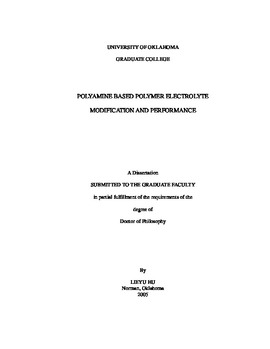| dc.contributor.advisor | Glatzhofer, Daniel T., | en_US |
| dc.contributor.author | Hu, Lieyu. | en_US |
| dc.date.accessioned | 2013-08-16T12:19:58Z | |
| dc.date.available | 2013-08-16T12:19:58Z | |
| dc.date.issued | 2005 | en_US |
| dc.identifier.uri | https://hdl.handle.net/11244/953 | |
| dc.description.abstract | Finally, lithium secondary batteries that function at room temperature were built using LPAG2EI based SPE and recycled at different temperatures and drain rates for preliminary evaluation. Although the recycling results were not consistently reproducible, we were able to obtain specific capacities about 90 mAh/g at 100 ° C with the charge/discharge current densities at 10/20 muA/cm2. With the increase of cycle number, the recycling efficiency gradually approached 100%. | en_US |
| dc.description.abstract | Linear poly(N-allylethylenimine-co-N-(2-(2-methoxyethoxy)ethylenimine) (LPAG2EI), in which the ratio between the allylic side-chain and G2 side-chain is roughly 1:1, was synthesized. Neutral SPEs with various amounts of LiTf were prepared using the optimum V-50 composition. IR indicates that Tf appears to exist mainly as 'free' ion while DSC shows a relatively low Tg (-15 ° C) and no crystalline phase even at a high salt composition (5:1, N:Li +). Cross-linked LPAG2EI/LiTf SPEs have good physical properties and outstanding ionic conductivity, above 10-5 S/cm at 35 ° C. | en_US |
| dc.description.abstract | A viable method for forming neutrally cross-linked solid polymer electrolytes (SPE) by synthetically combining both conductivity enhancing functionality and crosslink-enabling functionality on a polyamine backbone was established. In order to find an appropriate crosslinking functionality, inexpensive branched poly(N-allylethylenimine) (BPAEI) was synthesized from commercially available branched PEI. BPAEI was cross-linked using 2,2-azobis(2-amidinopropane) dihydrochloride (V-50) as radical initiator in the presence of LiTf to form a rubber-like SPE. Although IR shows most Tf ions stay as 'free' ions, the overall conductivity is poor due to a loss of polymer flexibility upon crosslinking as indicated by DSC. The highest conductivity achieved in this system is about 10 -5 S/cm at 80 ° C. The optimum conditions (20:1 N:Li+ ratio, 60:1 N:initiator) for best conductivity were determined. | en_US |
| dc.description.abstract | Relatively unexplored polyamine-based polymer electrolytes are being studied as key components in next generation power sources: high energy density and light weight solid state polymer batteries. Understanding the relationship between backbone modification and the resulting property changes of the polyamine-based polymer electrolytes is the focus of the first part of this dissertation. Linear poly(propyleneimine) (LPPI) was synthesized. LPPI were spectroscopically compared with linear poly(ethyleneimine) (LPEI) as a polymer electrolyte host for lithium trifluoromethanesulfonate (LiTf). Infrared spectroscopy (IR) reveals that the ionic association state of LPPI/LiTf is independent of salt concentration, while that of LPEI/LiTf shifts with salt concentration. Differential Scanning Calorimetry (DSC) shows a decrease of crystalline melting endotherms with increasing LiTf concentration in both systems. However, LPPI/LiTf has a relatively constant Tg with changing LiTf concentration, while that of LPEI/LiTf is LiTf concentration dependent. These observations show that both LPPI and LPEI are disrupted into crystalline and amorphous phases upon the addition of salt. However, the amorphous phase of LPPI/LiTf has a relatively constant composition while that of LPEI/LiTf is constantly changing. Consistent with these observations, LPPI/LiTf and LPEI/LiTf have different temperature-dependent ionic conductivity behaviors although they are of similar magnitude, up to 10-7 S/cm at room temperature and 10-3.5 S/cm at 70 ° C. Linear poly(N-methylpropylenimine) (LPMPI) was synthesized from LPPI and was compared to linear poly(N-methylethylenimine) (LPMEI). Research on LPMPI polymer electrolytes is ongoing. | en_US |
| dc.format.extent | viii, 139 leaves : | en_US |
| dc.subject | Chemistry, Polymer. | en_US |
| dc.subject | Lithium cells. | en_US |
| dc.subject | Polyelectrolytes. | en_US |
| dc.subject | Electric batteries. | en_US |
| dc.subject | Chemistry, Physical. | en_US |
| dc.subject | Chemistry, Organic. | en_US |
| dc.title | Polyamine-based polymer electrolyte modification and performance. | en_US |
| dc.type | Thesis | en_US |
| dc.thesis.degree | Ph.D. | en_US |
| dc.thesis.degreeDiscipline | Department of Chemistry and Biochemistry | en_US |
| dc.note | Source: Dissertation Abstracts International, Volume: 66-12, Section: B, page: 6627. | en_US |
| dc.note | Adviser: Daniel T. Glatzhofer. | en_US |
| ou.identifier | (UMI)AAI3203313 | en_US |
| ou.group | College of Arts and Sciences::Department of Chemistry and Biochemistry | |
